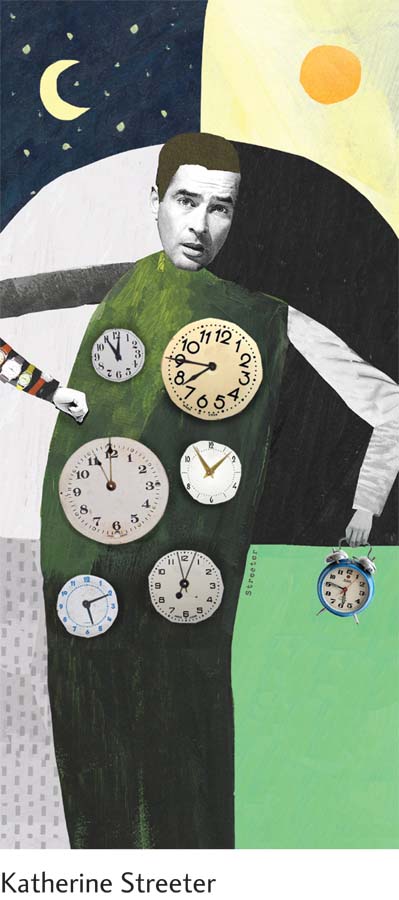Chapter Introduction
Why Do We Sleep
and Dream?
CLINICAL FOCUS 13-
ORIGINS OF BIOLOGICAL RHYTHMS
BIOLOGICAL CLOCKS
EXPERIMENT 13-
MEASURING BIOLOGICAL RHYTHMS
FREE-
ZEITGEBERS
CLINICAL FOCUS 13-
SUPRACHIASMATIC RHYTHMS
KEEPING TIME
PACEMAKING CIRCADIAN RHYTHMS
RESEARCH FOCUS 13-
PACEMAKING CIRCANNUAL RHYTHMS
COGNITIVE AND EMOTIONAL RHYTHMS
MEASURING HOW LONG WE SLEEP
MEASURING SLEEP IN THE LABORATORY
STAGES OF WAKING AND SLEEPING
A TYPICAL NIGHT’S SLEEP
CONTRASTING NREM SLEEP AND REM SLEEP
CLINICAL FOCUS 13-
DREAMING
WHAT WE DREAM ABOUT
SLEEP AS A BIOLOGICAL ADAPTATION
SLEEP AS A RESTORATIVE PROCESS
SLEEP AND MEMORY STORAGE
RETICULAR ACTIVATING SYSTEM AND SLEEP
NEURAL BASIS OF THE EEG CHANGES ASSOCIATED WITH WAKING
NEURAL BASIS OF REM SLEEP
DISORDERS OF NREM SLEEP
CLINICAL FOCUS 13-
DISORDERS OF REM SLEEP

13-1
Doing the Right Thing at the Right Time
We have all heard this advice: Maintaining regular sleeping and eating habits contributes to good health. Scientific evidence supports this good advice.
We humans are diurnal animals (from the Latin dies, meaning day): we are active during daylight and we sleep when it is dark. This circadian rhythm is the day–
Today our environment allows us to intrude on our circadian rhythm in two ways. Artificial lighting allows us to extend our waking hours well into the night and into sleep time. Handy food sources—
Together these intrusions into our natural circadian rhythm contribute to a combination of medical disorders known as metabolic syndrome that collectively increase the risk of developing sleep disorders, cardiovascular disease, and diabetes (Lajoie et al., 2015).
The roots of metabolic syndrome lie in disruptions of our biological clock, the neural system that times behavior. One clock controls sleep–
Irregular sleep and meal schedules thus change the synchrony of biological clocks. Metabolic rate, plasma glucose, and pancreatic insulin secretion can slow down or speed up at inappropriate times, contributing to obesity and diabetes. Prevention and treatment for obesity and diabetes can include doing the right thing at the right time when it comes to sleep schedules and mealtimes.

Humans and other animals perform a remarkable array of behaviors to adapt to daily and seasonal cycles. Our daily rhythms of sleeping and waking, feeding, exercising, and social interaction are rhythmical over days and years. Other animals share these daily activities and also migrate, hibernate, and shed or grow feathers or fur as the seasons change. In this chapter we answer questions related to these daily and seasonal rhythms, including how the brain produces biological rhythms, why sleep evolved, and what neural mechanisms regulate sleeping, waking, and sleep-